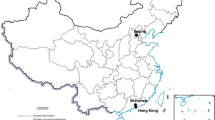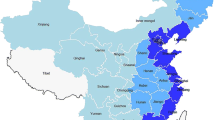Abstract
Circular economy plays an important role in carbon emissions reduction. To understand how the development of circular economy in China improve the carbon productivity is of great significance to realize China’s carbon peak and carbon neutrality goals. Due to the late introduction of the concept of carbon productivity, only a few studies have preliminarily analyzed the impact of the overall development of circular economy on carbon productivity at the macro level, but they ignored the different impact of different dimensions of the circular economy indicator system on carbon productivity at the micro level. In this context, this paper analyzes the impact of circular economy on carbon productivity by constructing an index evaluation system for the carbon reduction effect of circular economy through the two dimensions of resource efficiency and economic benefits and using the total factor carbon productivity measured by the DEA-Malmquist model and also analyzes the untapped potential of circular economy in different regions, which is expected to provide policy reference for how to achieve green and sustainable development in China under low-carbon constraints. Results show that first, the development of circular economy positively affects carbon productivity, and such promotion effect gradually strengthens with time. Meanwhile, the proposed indices demonstrate varying effects, with the resource efficiency indices outperforming the economic efficiency indices. Second, the varying degrees of circular economy development across regions lead to variations in the carbon reduction effect of circular economy on carbon productivity. Specifically, compared with the eastern and central regions, the western region shows the greater untapped potential of the circular economy. Identifying priorities for circular economy development, developing a circular economy in accordance with the local conditions, developing and utilizing advanced carbon emissions reduction technologies, and opening up further to the outside world have important theoretical value and practical significance for exploring the carbon emission reduction effect of circular economy.



Similar content being viewed by others
Data availability
All data generated or analyzed during this study are included in this published article.
References
Chen SY (2011) The fluctuation and decrease mode of China’s carbon emission intensity and economic explanation. J World Econ 34(04):124–143
Dong Z Q, Tan Y (2020) The relationship between economic freedom and green technological innovation and causes. Soc Sci Front 9th edn 99–109
Du K, Li J L (2019) Towards a green world: how do green technology innovations affect total-factor carbon productivity. Energy Policy 131(131)
Gao G, Wang K, Zhang C et al (2019) Synergistic effects of environmental regulations on carbon productivity growth in China’s major industrial sectors. Springer Neth 95(1–2)
Grossman G M, Krueger A B (1991) Environental impacts of a North America free trade agreement. NBER Working Pap NO. 3914.
Guo WX, Sun H (2020) Research on impact of environmental regulation and technical innovation on total factor carbon productivity: based on chinese provinces spatial panel data analysis. Sci Technol Manage Res 40(23):239–247
He YF, Zhu B, Hong LY et al (2010) Analysis on relationship between circular economy and low-carbon economy:based on resource productivity. J Technol Econ 29(12):68–73
Jiang M H,An H Z,GaoX Y et al (2021) Structural decomposition analysis of global carbon emissions: the contributions of domestic and international input changes. J Environ Manage 294
Li XP, Wang SB, Zhou JH (2014) Changes of carbon producitivity and the evolution of export sophistication:1992–2009. J Quant Tech Econ 31(09):22–39
Lin MS (2016) CO2 Emission reduce under China’s urban proces: the economic costand the strategies of emission redaction. J Quant Tech Econ 33(03):59–77
Lin J F, Wei L M, Hu Y J (2008) Green productivity, circular Economy and Sustainable Development of Economy. Ecol Econ 4th edn 71–74
Lu Z N, Yang Y, Wang J (2014) Factor decomposition of carbon productivity chang in China's main industries: based on the laspeyres decomposition method. Energy Procedia 61(61)
Panayotou T (1993) Empirical tests and policy analysis of environmental degradation at different stages of economic development.Pac Asian J Energy 4(1)
Qiao Q, Henry L (2019) Can the use of electric vehicles help China reduce carbon emissions?. China Financial News Network.http://www.cfen.com.cn/dzb/dzb/page_2/201911/t20191119_3424831.html.Accessed 20 Aug 2021
Shan H J (2008) Reestimating the capital stock of China:1952–2006. J Quant Tech Econ 25(10):17–31
Tang ZP, Liu WD, Song T (2017) Factors affecting China’s provincial carbon productivity based on mixed geographically weighted regression modeling. Resour Sci 39(12):2223–2232
Tenaw D, Hawitibo Alemu L (2021) Carbon decoupling and economic growth in Africa: evidence from production and consumption-based carbon emissions. Resour, Environ Sustainability 6
Wang C, Huang XJ, Zhai WX et al (2006) Evaluation of regional circular economy of industry for13cities of Jiangsu Province. Environ Pollution Control 06:472–475
Wang Y (2021) The contribution of circular economy to carbon emission reduction can reach about half. China Development Network. https://baijiahao.baidu.com/s?id=1709227779477357035&wfr=spider&for=pc. Accessed 27 Aug 2021
Xi Y L, Niu G M (2021) An empirical study on the relationship between carbon emissions and economic growth: empirical evidence based on international panel data. Mod Manage Sci 8th edn 13–25
Yan J L, Ran Q Y, Su X F et al (2020) Research on the effect of foreign trade on promoting carbon emission reduction. Price Theory Pract 11th edn 149–152+184
Yang X, Li XP, Zhou DC (2015) Study on the difference and convergence of carbon productivity in chinese manufacturing. J Quant Tech Econ 32(12):3–20
Yang D Y, Li J, Yang X (2021) Research on the impact of environmental regulation on the regional carbon productivity of China. J Southwest Univ (Nat Sci Ed) 5th edn 110–120
Yu Y N, Choi Y, Wei X et al (2017) Did China's regional transport industry enjoy better carbon productivity under regulations?. J Cleaner Prod 165(165)
Zaidi S A H, Hussain M, uz Zaman Q (2021) Dynamic linkages between financial inclusion and carbon emissions: Evidence from selected OECD countries. Resour, Environ Sustainability PP 100022
Zhang Y J (2011) Technical progress, industrial structure and carbon productivity growth. China Sci Technol Forum 5th edn 114–120
Zhang DY (2021) The carbon emission reduction path of the EU and Japan has important reference significance for China. China Econ Trade Herald 15:50–51
Zhang CQ, Chen PY (2021) Industrialization, urbanization, and carbon emission efficiency of Yangtze river economic belt-empirical analysis based on stochastic frontier model. Environ Sci Pollution Res Int 28(47):66914–67669
Zhang LL, Xiong LC, Cheng BD et al (2018) How does foreign trade influence China’s carbon productivity? based on panel spatial lag model analysis. Struct Change Econ Dyn 47:171–179
Acknowledgements
The authors wish to express their gratitude to the Beijing University of Technology for logistic and technical assistance.
Funding
This work was supported by the National Social Science Foundation of China (Grant No. 18BGL183) and the Social Science Foundation of Beijing (Grant No. 14JGB037).
Author information
Authors and Affiliations
Contributions
All authors contributed to the study conception and design. Conceptualization, writing — review and editing, and supervision were performed by CT. The first draft of the manuscript was written by ZY and all authors commented on previous versions of the manuscript. All authors read and approved the final manuscript.
Corresponding author
Ethics declarations
Ethics approval and consent to participate
Not applicable.
Consent for publication
Not applicable.
Competing interests
The authors declare no competing interests.
Open access
This article is licensed under a Creative Commons Attribution 4.0 International License, which permits use, sharing, adaptation, distribution and reproduction in any medium or format, as long as you give appropriate credit to the original author(s) and the source, provide a link to the Creative Commons licence, and indicate if changes were made. The images or other third party material in this article are included in the article’s Creative Commons licence, unless indicated otherwise in a credit line to the material. If material is not included in the article’s Creative Commons licence and your intended use is not permitted by statutory regulation or exceeds the permitted use, you will need to obtain permission directly from the copyright holder. To view a copy of this licence, visit http://creativecommons.org/licenses/by/4.0/.
Additional information
Responsible Editor: Roula Inglesi-Lotz.
Publisher's note
Springer Nature remains neutral with regard to jurisdictional claims in published maps and institutional affiliations.
Rights and permissions
About this article
Cite this article
Cui, T., Zhang, Y. Research on the impact of circular economy on total factor carbon productivity in China. Environ Sci Pollut Res 29, 78780–78794 (2022). https://doi.org/10.1007/s11356-022-21314-7
Received:
Accepted:
Published:
Issue Date:
DOI: https://doi.org/10.1007/s11356-022-21314-7




